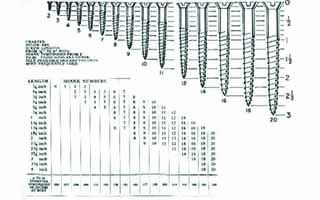Understanding Screw Sizes

What do all of those screw numbers mean? It's a good thing to know – plans, instructions, specs and other woodworkers refer to specific kinds and sizes of screws all the time. Below, Lee Grindinger clears up the mystery in his response to a Woodworker’s Journal reader's question.
Woodworking Question Why are some screws listed by diameter and threadcount (3/8-16) and others are just #6 or whatever? Or, perhaps more to the point, what does a #6 or #8 screw translate into?
Answer from Lee Grindinger: Well, it's not as simple as you may suspect. All screws are listed by diameter but the terms used for different types of screws vary. A 3/8"-16 screw is a machine screw, the "3/8" is the diameter and the "16" is the number of threads per inch. This screw will thread into a nut or threaded hole.
Wood screws are tapered and thread count is not part of the description. A gage number like "6" is the diameter and the length is the length of the screw that goes into the wood not inclusive of the head unless it's a flat head. The smaller the gage number the smaller the screw diameter (opposite of nails and wire diameter).
Screw heads come in a plethora of configurations as well, from driver type like Slotted, Phillips, Square and Robinson, to shape of the head like Round, Flat and Oval.
Drywall screws are sized by gage (diameter) and length and come in either coarse or fine thread. Get a full scale chart to hang on your wall in the shop. Once you get the hang of the system identifying the screw you need, it's not too difficult, but it is confusing at first.
Make sense? If you need screws, including some of the more exotic varieties, like square-X drive lube finished screws or double locking assembly screws, you'll find them - along with just about every other screw type - at Rockler.
Keep the inspiration coming!
Subscribe to our newsletter for more woodworking tips and tricks
